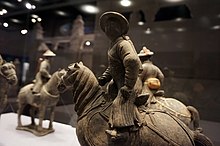| Terlig | |||||||
|---|---|---|---|---|---|---|---|
 Riding male figure wearing the Mongol Yuan Terlig, also known as bianxiaoao (辫线袄). | |||||||
| Chinese name | |||||||
| Traditional Chinese | 貼裏 | ||||||
| Simplified Chinese | 帖裡 | ||||||
| |||||||
| Korean name | |||||||
| Hangul | 철릭 | ||||||
| Hanja | 貼裏/帖裏 | ||||||
| |||||||
Terlig, also known as tieli (simplified Chinese: 帖裡; traditional Chinese: 貼裏; pinyin: tiēlǐ) or bianxianao (simplified Chinese: 辫线袄; traditional Chinese: 辮線襖; pinyin: biànxiànǎo; lit. 'coat with plaited line') or Yaoxianao[zi] (simplified Chinese: 腰线袄[子]; traditional Chinese: 腰線襖[子]; pinyin: yāoxiànǎo[zi]; lit. 'coat with waist line') in Chinese, or commonly referred as Mongol dress or plait-line robe, is an archetypal type of Mongol clothing for men.[1][2]: 49 [3]: 75–76 [4]
The terlig was initially developed to accommodate the culture, the equestrian and nomadic lifestyle of the Mongols, and to protect their bodies from the cold temperature of steppe regions.[1] It was sometimes decorated with cloud collar (Chinese: 雲肩; pinyin: yunjian; lit. 'cloud-shoulder') pattern which decorated around the robe's collar, chest, and shoulders area.[1][2]: 49–51 As the terlig gained symbolic meaning with time and as it spread into different regions, its shape and design evolved.[1] Hybrid forms of the terlig was developed as it came in contact with other local cultures.[1] The terlig was worn in China, Central Asia, Korea, and in the Mughal Empire in India.[1] It is still worn as Mongol ethnic clothing in some regions.[1]
- ^ a b c d e f g Cho, Woohyun; Yi, Jaeyoon; Kim, Jinyoung (2015). "The dress of the Mongol Empire: Genealogy and diaspora of theTerlig". Acta Orientalia Academiae Scientiarum Hungaricae. 68 (3): 22–29. doi:10.1556/062.2015.68.3.2. ISSN 0001-6446.
- ^ a b Shea, Eiren L. (2020). Mongol court dress, identity formation, and global exchange. New York, NY. ISBN 978-0-429-34065-9. OCLC 1139920835.
{{cite book}}: CS1 maint: location missing publisher (link) - ^ Y., Watt, James C. (2010). The world of Khubilai Khan : Chinese art in the Yuan Dynasty. Metropolitan Museum of Art. pp. 75–76. ISBN 978-1-58839-402-6. OCLC 696014331.
{{cite book}}: CS1 maint: multiple names: authors list (link) - ^ Baohai, Dang; 党寶海; Dang, Baohai (2003). "The Plait-line Robe. A Costume of Ancient Mongolia". Central Asiatic Journal. 47 (2): 198–216. ISSN 0008-9192. JSTOR 41917645.